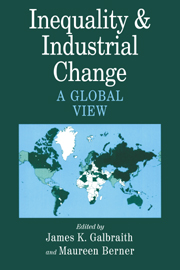Book contents
- Frontmatter
- Contents
- Contributors
- Permissions
- Acknowledgments
- PART I INTRODUCTION TO THEORY AND METHOD
- PART II INEQUALITY, UNEMPLOYMENT, AND INDUSTRIAL CHANGE
- PART III INEQUALITY AND DEVELOPMENT
- 7 Toward a New Kuznets Hypothesis: Theory and Evidence on Growth and Inequality
- 8 Measuring the Evolution of Inequality in the Global Economy
- 9 Economic Regionalization, Inequality, and Financial Crises
- 10 Inequality and State Violence: A Short Report
- 11 Grading the Performance of Latin American Regimes, 1970–1995
- 12 The Evolution of Industrial Earnings Inequality in Mexico and Brazil
- 13 The Legacy of the HCI: An Empirical Analysis of Korean Industrial Policy
- 14 Inequality and Economic Development: Concluding Reflections
- PART IV METHODS AND TECHNIQUES
- Data Appendix
- References and Selected Bibliography
- Index
11 - Grading the Performance of Latin American Regimes, 1970–1995
Published online by Cambridge University Press: 05 June 2012
- Frontmatter
- Contents
- Contributors
- Permissions
- Acknowledgments
- PART I INTRODUCTION TO THEORY AND METHOD
- PART II INEQUALITY, UNEMPLOYMENT, AND INDUSTRIAL CHANGE
- PART III INEQUALITY AND DEVELOPMENT
- 7 Toward a New Kuznets Hypothesis: Theory and Evidence on Growth and Inequality
- 8 Measuring the Evolution of Inequality in the Global Economy
- 9 Economic Regionalization, Inequality, and Financial Crises
- 10 Inequality and State Violence: A Short Report
- 11 Grading the Performance of Latin American Regimes, 1970–1995
- 12 The Evolution of Industrial Earnings Inequality in Mexico and Brazil
- 13 The Legacy of the HCI: An Empirical Analysis of Korean Industrial Policy
- 14 Inequality and Economic Development: Concluding Reflections
- PART IV METHODS AND TECHNIQUES
- Data Appendix
- References and Selected Bibliography
- Index
Summary
For most of Latin America, the 1970s were a decade of growth, though with political upheaval in Argentina and Chile. The 1980s were a disaster. The 1990s saw economic reform, liberalization, a return to democracy, and financial turmoil. This chapter reviews the three decades as one piece through an analysis of the evolution of earnings inequality from year to year in eight major Latin American countries and one Caribbean nation. We find that changes in earnings inequality are a sensitive indicator of slump, repression, political turmoil, civil war, natural disaster, and – on the positive side – occasional periods of growth and stability in Latin America. Indeed, almost the whole recent history of Latin America can be summarized in the movement of industrial inequality statistics.
Introduction
This chapter focuses on the relationship between industrial earnings inequality and the political history of Latin America. First, we offer a word on the data and the method used to construct a measure of the movement of industrial earnings inequality for each of the countries under study. Second, we investigate the relationship between political regimes and changes in earnings inequality for each of the countries, including orthodox and heterodox stabilizations and the transition from closed to open trading systems. Third, we examine the relationship between economic growth and our measurement of inequality and present the report card for each of the regimes of the countries studied. Conclusions stressing policy implications complete the chapter.
- Type
- Chapter
- Information
- Inequality and Industrial ChangeA Global View, pp. 212 - 226Publisher: Cambridge University PressPrint publication year: 2001



